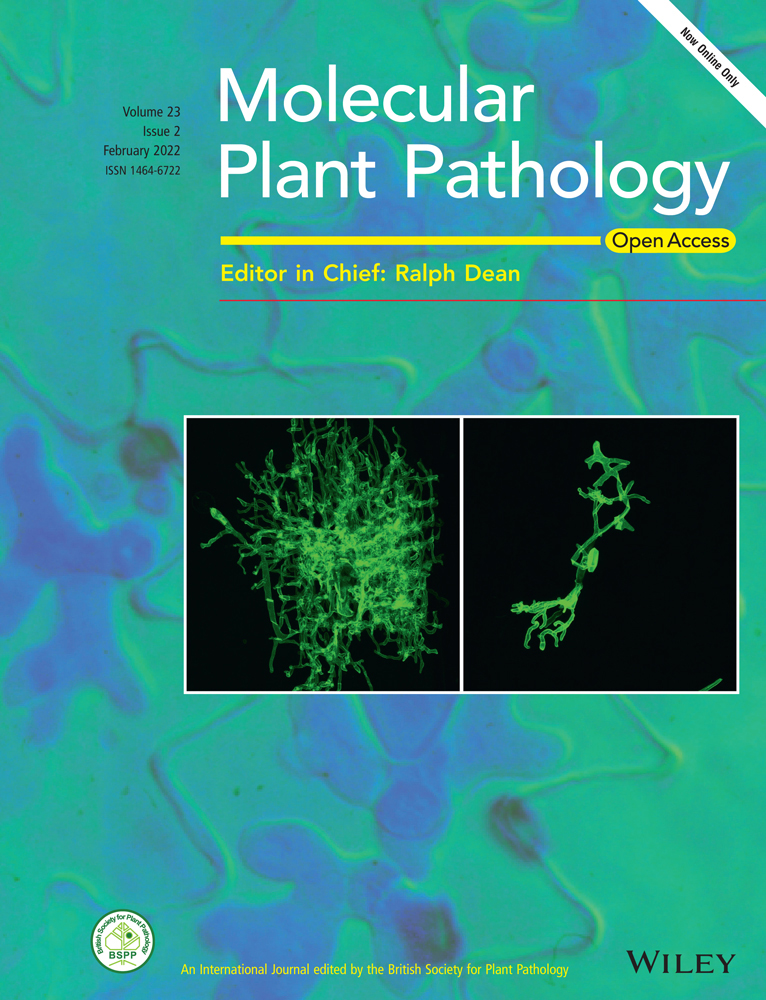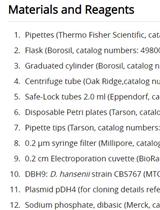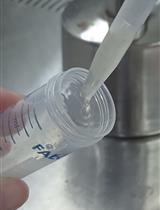- EN - English
- CN - 中文
Simple Growth Complementation Assay in Yeast
酵母中植物单糖转运蛋白的简单生长互补分析
发布: 2023年08月05日第13卷第15期 DOI: 10.21769/BioProtoc.4733 浏览次数: 1706
评审: Anu P. MinhasAnonymous reviewer(s)
Abstract
The study of genes and their products is an essential prerequisite for fundamental research. Characterization can be achieved by analyzing mutants or overexpression lines or by studying the localization and substrate specificities of the resulting proteins. However, functional analysis of specific proteins in complex eukaryotic organisms can be challenging. To overcome this, the use of heterologous systems to express genes and analyze the resulting proteins can save time and effort. Yeast is a preferred heterologous model organism: it is easy to transform, and tools for genomics, engineering, and metabolomics are already available. Here, we describe a well-established and simple method to analyze the activity of plant monosaccharide transporters in the baker’s yeast, Saccharomyces cerevisiae, using a simple growth complementation assay. We used the famous hexose-transport-deficient yeast strain EBY.VW4000 to express candidate plant monosaccharide transporters and analyzed their transport activity. This assay does not require any radioactive labeling of substrates and can be easily extended for quantitative analysis using growth curves or by analyzing the transport rates of fluorescent substrates like the glucose analog 2-NBDG. Finally, to further simplify the cloning of potential candidate transporters, we provide level 0 modular cloning (MoClo) modules for efficient and simple Golden Gate cloning. This approach provides a convenient tool for the functional analysis of plant monosaccharide transporters in yeast.
Key features
• Comprehensive, simple protocol for analysis of plant monosaccharide transporters in yeast
• Includes optional MoClo parts for cloning with Golden Gate method
• Includes protocol for the production and transformation of competent yeast cells
Does not require hazardous solutions, radiolabeled substrates, or specialized equipment
Keywords: Yeast (酵母)Background
In the past decade, the availability of full genome sequences, powerful genome engineering tools, and innovations in transcriptomics and metabolomics have revolutionized plant research (Rai et al., 2019; Purugganan and Jackson, 2021; Wang and Doudna, 2023). Plant sugar transporters are an important area of research, as they play a crucial role in delivering sugars as energy sources for developmental processes, contribute to disease resistance mechanisms, and are key determinants of yield (Julius et al., 2017; Bezrutczyk et al., 2018; Breia et al., 2021). However, the analysis of individual transporter candidates or transporter mutants is challenging because plant genomes are complex and sugar transporters are often organized in large gene families. To solve this bottleneck, heterologous systems, such as the baker’s yeast Saccharomyces cerevisiae, are powerful tools for analyzing plant sugar transporter functions on a single scale (Boles, 2003). Yeast is easy to transform, and many different strains with various phenotypes exist, which are suitable for analyzing specific sugar-transport abilities. In this protocol, we used the well-known hexose-transport-deficient strain EBY.VW4000 to analyze the activity of plant monosaccharide transporters and their mutants (Wieczorke et al., 1999). Instead of measuring the uptake of radioactively labeled substrates, as described in other protocols (Milne et al., 2017), this protocol describes a simple and cost-effective drop-out assay. Therefore, the hexose-transport-deficient strain EBY.VW4000 is transformed with expression constructs for the monosaccharide transporter of interest. A dilution series of the complemented EBY.VW4000 strains is spotted on selective plates to determine their growth on different carbon sources like maltose or glucose. The described protocol has already been extensively used in many studies dealing with sugar transporters (e.g., Chen et al., 2010; Moore et al., 2015; Skoppek et al., 2022; Tamayo et al., 2022; Yue et al., 2023). To provide a comprehensive workflow, we also implemented a protocol for the production of competent yeast cells and for transformation. This approach is based on the protocols described by Gietz and Schiestl (2007a and 2007b) and has been optimized for EBY.VW4000. Finally, we provide optional level 0 modular cloning (MoClo) modules for the yeast PMA1 promoter (plasma membrane H+ ATPase 1) and the ADH2 (alcohol dehydrogenase 2) terminator, which are commonly used for the expression of transporters in yeast (Meyer et al., 2006; Skoppek et al., 2022). These modules allow an easy and cost-effective cloning of new constructs using the Golden Gate cloning method (Engler et al., 2009; Werner et al., 2012).
The described drop-out assay is a simple method to rapidly screen for the transport activities of transporter candidates. However, if quantitative analysis is needed, we suggest extending this analysis to a growth curve or by analyzing the transport rate of fluorescent sugar analogs [for example esculin (sucrose analog) or 2-NBDG (glucose analog)] (Gora et al., 2012; Roy et al., 2015).
Materials and reagents
Biological materials
Saccharomyces cerevisiae strain EBY.VW4000 (hexose transport-deficient)
Genotype: CEN.PK2-1C hxt13Δ::loxP hxt15Δ::loxP hxt16Δ::loxP hxt14Δ::loxP hxt12Δ::loxP hxt9Δ::loxP hxt11Δ::loxP hxt10Δ::loxP hxt8Δ::loxP hxt4-1-5Δ::loxP hxt2Δ::loxP hxt3-6-7Δ::loxP gal2Δ::(ura3/FOA) stl1Δ::loxP agt1Δ::loxP mph2(ydl247w)Δ::loxP mph3(yjr160c)Δ::loxP
(Wieczorke et al., 1999)
For more information about the choice of suitable yeast strains see General Note 1.
Reagents
Agar-agar, Kobe I (Carl Roth, catalog number: 5210.5)
Peptone from meat (Carl Roth, catalog number: 2366.1)
Yeast synthetic drop-out medium supplements, without uracil (amino acid mix -Ura) Merck KGaA, catalog number: Y1501-20G)
Yeast extract (Carl Roth, catalog number: 2363.4)
Yeast nitrogen base without amino acids (YNB) (Merck KGaA, catalog number: Y0626-250G)
D-Glucose monohydrate (Duchefa B.V., catalog number: G0802.1000)
D(+)-maltose monohydrate (Carl Roth, catalog number: 8951.4)
Salmon sperm DNA sodium salt (Carl Roth, catalog number: 5434.1)
Lithium acetate dihydrate (LiAc) (LiCH3COO·2H2O) (Carl Roth, catalog number: 6713.1)
Poly(ethylene glycol) 3350, PEG3350, H(OCH2CH2)nOH (Merck KGaA, catalog number: P4338)
Dimethyl sulfoxide (DMSO), (CH3)2SO (Merck KGaA, catalog number: 276855-1L)
Glycerol (C3H8O3) 86% (Carl Roth, catalog number: 4043.3)
Sodium chloride (NaCl) (Carl Roth, catalog number: 3957.2)
Potassium chloride (KCl) (AppliChem GmbH, catalog number: A1039.1000)
Tris (C4H11NO3) (Carl Roth, catalog number: AE15.3)
Ethylenediamine tetra acetic acid disodium salt dihydrate (EDTA), C10H14N2Na2O8·2H2O (Carl Roth, catalog number: 8043.2)
1 N hydrochloric acid (HCl) or any other non-fuming HCl (Carl Roth, catalog number: 6792.1)
1 N sodium hydroxide (NaOH) or similar (Carl Roth, catalog number: 6785.1)
ddH2O (sterile)
Optional: MoClo plasmids level 0 and ready-to-use level 1
pJS506 [PMA1 promoter (Pro5U module), pICH41295, GGAG-AATG (BsaI)] (Addgene, #200712)
pJS237 [ADH2 terminator (3′U+Ter module), pUCGent, GCTT-CGCT (BsaI)] (Addgene, #200713)
pJS288 [Hxt1 transcription unit (Level 1 TU, P1), pAGT572, TGCC-GCAA (BpiI)] (Addgene, #200714)
Acceptor vectors: pAGT572 (selection marker for uracil) was a kind gift from Sylvestre Marillonnet and Alain Tissier (Scheler et al., 2016). Alternative yeast-compatible vectors is, for example, pJOG417 (Addgene #105341; selection marker for leucine) (Gantner et al., 2018)
Solutions
20% glucose solution (sterile filtered)
20% maltose solution (sterile filtered)
14% glycerol solution
YPM medium (see Recipe 1)
Frozen competent cell solution (FCC) (see Recipe 2)
10× yeast synthetic drop-out medium supplements, without uracil, (amino acid mix -Ura) (see Recipe 3)
YNB medium with amino acid mix -Ura and carbon source (see Recipe 4)
50% PEG 3350 (autoclaved) (see Recipe 5)
1 M LiAc (sterile filtered) (see Recipe 6)
Salmon sperm carrier DNA (2 mg/mL) (see Recipe 7)
1 M Tris-HCl (pH 8.0) (see Recipe 8)
0.2 M EDTA (pH 8.0) (see Recipe 9)
10 mM TE buffer (pH 8.0) (see Recipe 10)
Recipes
YPM medium (full medium with maltose)
Reagent Final concentration Amount Yeast extract 1% (w/v) 5 g Peptone 2% (w/v) 10 g Maltose 2% (w/v) 10 g Agar-agar (optional for plates) 2% (w/v) 10 g ddH2O n/a Ad 500 mL Autoclave. Pour plates with solid medium.
Note: If needed for a certain yeast strain, the carbon source can be replaced by glucose, galactose, or glycerol. Maltose was most suitable to grow EBY.VW4000.
Frozen competent cell solution (FCC)
Reagent Final concentration Amount Glycerol 5% (v/v) 5 mL DMSO 10% (v/v) 10 mL Total n/a Ad 100 mL Store FCC at room temperature (RT).
10× yeast synthetic drop-out medium supplements, without uracil (amino acid mix -Ura)
Reagent Final concentration Amount Yeast synthetic drop-out medium supplements, without uracil (amino acid mix -Ura) 10× 1.92 g ddH2O n/a Ad 100 mL Filter sterilize. Store at 4 °C and protect from light.
Note: To dissolve the supplements in water, stir the solution on a magnetic stirrer. Carefully warm the solution (maximum 50 °C) if the supplements do not dissolve well. Always tightly close the stock bottle with the supplements after usage, to prevent the powder from absorbing water. For additional information on how to choose the yeast synthetic drop-out medium, see General Note 2.
YNB medium with amino acid mix -Ura and carbon source
To prepare 500 mL of YNB medium with amino acid mix -Ura and carbon source, first weigh the required amount of YNB and dissolve in 400 mL of water. For solid plates, add 2% agar-agar. Autoclave and store until usage.
Reagent Final concentration Amount YNB n/a 3.35 g Agar-agar (optional for plates) 2% (w/v) 10 g ddH2O n/a Ad 400 mL For solid medium: Carefully boil up the medium in a microwave. Secondly, add the following supplements before use:
Reagent Final concentration Amount 20% carbon source1 2% (v/v) 50 mL 10× amino acid mix -Ura (Recipe 3) 1% (v/v) 50 mL For solid medium: pour plates.
1The carbon source is chosen according to the intended use of the medium. For the required carbon source, e.g., glucose, maltose, or similar, a 20% stock solution is prepared in water, filter sterilized, and stored at RT until use. For selection and cultivation of transformed EBY.VW4000 strains, add maltose as carbon source. For performing the drop-out assay on different carbon sources, add the required sugar, e.g., glucose.
50% PEG 3350
Reagent Final concentration Amount PEG 3350 50 % 50 g ddH2O n/a Ad 100 mL Autoclave, store at RT.
1 M LiAc
Reagent Final concentration Amount PEG 3350 1 M 10.2 g ddH2O n/a Ad 100 mL Autoclave, store at RT.
Salmon sperm carrier DNA (2 mg/mL)
Reagent Final concentration Amount Salmon sperm carrier DNA 2 mg /mL (w/v) 8 g 10 mM TE buffer (Recipe 8) 10 mM Ad 4 mL Dissolve the salmon sperm carrier DNA in 10 mM TE buffer on ice for 3–4 h with gentle shaking. Prepare aliquots, for example with 500 μL each. Incubate the aliquots for 10 min at 95 °C and immediately transfer to ice. Store at -20 °C.
1 M Tris-HCl (pH 8.0)
Reagent Final concentration Amount Tris 1 M 12.114 g ddH2O n/a Ad 100 mL Dissolve Tris in 80 mL of ddH2O and adjust the pH to 8.0 by carefully adding drops of HCl (1 N or any other non-fuming HCl). Fill up the volume to 100 mL.
0.2 M EDTA
Reagent Final concentration Amount EDTA 200 mM 7.44 g ddH2O n/a Add 100 mL Dissolve EDTA in 80 mL of ddH2O and adjust the pH to 8.0 by carefully adding NaOH (1 N NaOH solution or pellets). Fill up the volume to 100 mL.
10 mM TE-buffer (pH 8.0)
Reagent Final concentration Amount Tris-HCl pH 8.0 10 mM 1 mL EDTA pH 8.0 1 mM 0.5 mL ddH2O n/a 98.5 mL
Laboratory supplies
Squared Petri dishes for drop-out (Carl Roth, catalog number: EL50.1)
Petri dish (Sarstedt, catalog number: 82.1473.001)
2 mL reaction tube (Sarstedt, catalog number: 72.695.500)
Parafilm
Disposable gloves
50 mL reaction tubes (Sarstedt, catalog number: 62.547.254)
Equipment
Biosafety cabinet or bench with flame
Pipettes
Photometer (e.g., IMPLEN, OD600 DiluPhotometer; or similar)
Tabletop centrifuge (e.g., Eppendorf Micro Centrifuge 5425, maximum 21,300 rcf or similar)
Centrifuge for 50 mL reaction tubes (e.g., Eppendorf 5810R, maximum 20,913 rcf or similar)
Mobile phone or any other camera device
Optional: INTEGRA multichannel pipet Voyager (INTEGRA Biosciences GmbH, catalog number: 4721)
Optional: INTEGRA tips (INTEGRA Biosciences GmbH, e.g., as box 3416 or as bag 4411)
Procedure
文章信息
版权信息
© 2023 The Author(s); This is an open access article under the CC BY-NC license (https://creativecommons.org/licenses/by-nc/4.0/).
如何引用
Fuhrmeister, R. and Streubel, J. (2023). Simple Growth Complementation Assay in Yeast. Bio-protocol 13(15): e4733. DOI: 10.21769/BioProtoc.4733.
分类
植物科学 > 植物分子生物学 > 蛋白质
分子生物学 > DNA > 转化
您对这篇实验方法有问题吗?
在此处发布您的问题,我们将邀请本文作者来回答。同时,我们会将您的问题发布到Bio-protocol Exchange,以便寻求社区成员的帮助。
提问指南
+ 问题描述
写下详细的问题描述,包括所有有助于他人回答您问题的信息(例如实验过程、条件和相关图像等)。
Share
Bluesky
X
Copy link












